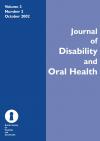Journal of Disability and Oral Health

- Cover Date:
- October 2002
- Print ISSN:
- 1470-8558
- Electronic ISSN:
- 1754-2758
- Vol:
- 3
- Issue:
- 2
Letters to the Editor
Dear Madam We welcome discussion of the role of preoperative sedation in facilitating dental care for Special Needs patients. Our experience of outpatient general anaesthesia (GA) for dental treatment in this group of patients mirrors that of Butterworth et al. (J Disabil Oral Health 2002; 3: 3–6) with a few differences. We find that the provision of a dedicated dental GA suite within the dental department is much less daunting for the patient than an operating theatre setting. Within this setting we spend one session a month working as a dental and anaesthetic team, assessing referred patients not only in terms of their dental needs but also as to the best approach to facilitate general anaesthesia. On a case-by-case individual basis we then decide what preoperative tests can be done and plan a strategy with the carers as to the least traumatic way of approaching the treatment required. In this setting, we find that sedation is a useful tool tailored to individual treatment plans. Rehearsal and familiarisation of the patient to the environment of the GA treatment room can be useful in the first instance, although the really determined Autistic Spectrum Disorder patients can be impossible even at levels of sedation that it would be unwise to exceed in an outpatient setting. We find that the most efficacious method is to give the patient 10 to 20mg of diazepam at home before travelling. If the patient needs more sedation we then augment this with oral midazolam once they have arrived in the hospital. Care must be taken that the volume of preoperative fluid is not excessive. We differ in that we tend to undertake intravenous induction of anaesthesia, as many patients, even when sedated, will panic in the early stages of induction, not allowing extended gaseous induction. We also tend to avoid nasal intubation as nose bleeds and the subsequent swallowing of blood leads to postoperative nausea, a particular problem for outpatient anaesthesia. Most anaesthetic procedures are performed without muscle relaxation, with the patient spontaneously breathing with a laryngeal mask airway. The airway can be protected from flooding / fragments not only by placement of throat packs but also by close coordination between the dental surgeon and anaesthetist. The use of suxemethonium is undesirable as a routine due to its many side effects so we tend to use a non-depolarising agent if we need to paralyse a patient. Adequate local anaesthesia is mandatory on top of general anaesthesia for painful procedures. With time these patients will require further treatments and if the memory of the last time is painful the next procedures will become increasingly difficult. We abhor the use of strong-arm tactics either physically or pharmacologically, and hence find ketamine unsuitable for day-case work. Occasionally we fail: a profoundly phobic patient that needed 60mg of diazepam to get to the hospital, added a bottle of whisky at her own initiative and was sedated enough to be treated under local anaesthesia! Dr M Wrigley MB BS FRCA email mark@gasm.demon.co.uk Consultant Anaesthetist Mrs. N Kumar BDS, FDS RCS (Eng) Senior Dental Officer The ACAD Centre, The Central Middlesex Hospital, Acton Lane, London NW10, UK
- Article Price
- £0.00
- Institution Article Price
- £0.00
- Page Start
- 95
- Page End
- 95
- Authors
Articles from this issue
- Title
- Pg. Start
- Pg. End
- Swalloaid, a new prosthetic appliance for edentulous elderly people with dysphagia: a case report
- 72
- 76
